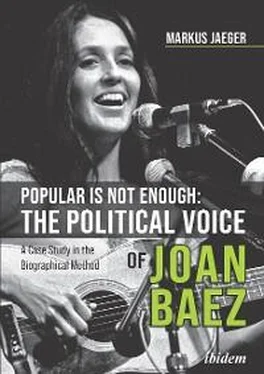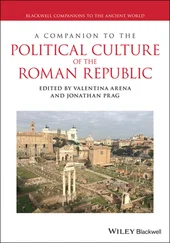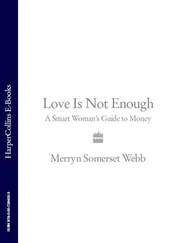1. Stepping Over Boundaries: Materials, Methodology and Theory
Introduction
The aim of this first chapter is to sketch the theoretical background for my line of argumentation. Additionally, a description of the main method outlines the reasons why the biographical method (or life history) is the most profitable approach to the work of Joan Baez. In this manner, sources and materials used to verify the main thesis are explained. On the following pages, five sub-chapters examine these columns of my research in more detail.
The first step is to plea for open-mindedness regarding the interdisciplinary approach that I take with my analysis, because it can be very unsatisfying to limit research possibilities to one scientific branch only. Secondly, an excursion adds an explanation about the cross-border element of social movements, in view of the fact that they offer Baez’s main professional platform, where she melts the borderline between her artistic and her political work. The third sub-chapter offers a summarizing investigation of the biographical method, discussing necessary conditions and advantages of the life history, which is the main methodological approach to my analysis of Baez’s combination of art and activism. The fourth step is a closer look at the challenging relationship between popular culture and politics. It explains the reason why I refer to Baez as a popular singer and how far this classification can be a helpful means for a discussion about her political endeavors. As a last step, the incorporation of Baez’s work with Theodor W. Adorno’s aesthetic theory juxtaposes the activeness of Baez’s efforts to the passiveness of Adorno’s theory as well as his slack use of musical categories—falsifying his resigned approach to the authenticity of politically active artists (particularly in the field of popular culture). The most valuable way of building these columns of my analysis is to consider more than one scientific discipline for my research.
1.1 Against Wrongful Restrictions: On the Advantages of Interdisciplinarity
Picking out singer and activist Joan Baez as the central theme for a dissertation reveals a manifold number of risks and poses numerous questions. Satisfying answers to these questions can not be found by sticking entirely to one particular discipline only—meaning: to one specific body of knowledge, which is being delimited from other scientific disciplines. Moran analyses an important aspect of this kind of systematic delimitation: “[…] in fact, the very notion of the term [discipline] as a recognized mode of learning implies the establishment of hierarchy and the operation of power […]” (Moran 2). This is the reason why interdisciplinarity can be regarded as an attempt to overcome structures of limited power; limited to a small number of selected scientists of one single discipline as well as limited in its potential of achieving knowledge. In other words: the often underestimated “[…] teamwork […]” (Rodgers, Booth and Eveline 2003) of different scientific disciplines is a helpful means of producing knowledge, because knowledge is achieved via the verification of hypotheses—regardless on which hierarchical level of a scientific discipline’s power within the academia.
The stability of putting knowledge into structured schemes—enabling us to go back to organized information more easily—shall by no means be generally put into question. Barker, all the same, correctly emphasizes the fact that “[…] many cultural studies practitioners have felt ill at ease with the forging of institutional disciplinary boundaries for the field […]” (Barker Making Sense 6). The most incisive boundary that I attempt to overcome is the often far too strict line between the humanities and the social sciences. McClung Lee refers to the process of melting this particular boundary as “Humanist Sociology”, explaining reasons why it can be fruitful to approach research from a humanist’s as well as a social scientist’s point of view: “[…] interdisciplinary contacts, including ones with stimulating artists, are useful to build resistance against closure tendencies, against overlooking alternative views of reality […]” (McClung Lee x). Consequentially, the unbending attention to one scientific discipline only includes the danger of overlooking alternative ways to the verification of hypotheses.
Ignoring possible elitist attitudes, which—in a generalizing manner—dismiss such a form of interdisciplinarity as scientific “[…] vulgarization […]” (McClung Lee 151), my intellectual focus follows what McClung Lee describes as “[…] searching for reality in its historical and cross-cultural contexts and […] what appears most relevant […] to our society […]” (McClung Lee xi). This definition can well be applied to the work of Joan Baez. Social movements offer the most interesting platform and potential for a successful expression of this continual attempt to non-violently fight against (what is considered to be) social injustice.
1.2 Reconstituting Culture: On the Significance of Social Movements
Social movements offer a concrete manifestation of the melting borderline between culture and politics. Apart from being driven by instantly recognizable political issues, Chester and Welsh summarize their essence in the following definition: for them, social movements are networks, which “[…] have employed confrontational, imaginative, and highly symbolic repertoires of collective action based upon the ethos of ‘direct action for direct democracy’ […]” (Chester and Welsh, 97). Chapters 4 until 10 of this study present a chronological analysis of the way Baez has supported a variety of social movements throughout her career. Their significance for social change can not be underestimated, as they form appropriate forces for the development of culture; or—in the words of Eyerman and Jamison—they are “[…] central moments in the reconstitution of culture […]” (Eyerman and Jamison 6). While social movements are driven by particular political intentions—their efforts can shape significant breaks in the cultural development of society.
For a public figure like Joan Baez, artistic work alone is not enough to lead a satisfying professional life. She uses her fame as a singer and songwriter of national and international renown to support initiatives which successfully co-create a political climate in which the constant attempt to revive organized non-violence turns into a (repeatedly successful) means of overcoming organized violence. One of the most important conditions for such a course of action is the implementation of social movements, which represent the main professional platform for an artist and activist like Baez. Eyerman and Jamison constructively define the importance of social movements, already connecting it to the field of popular culture: “[…] through their impact on popular culture, mores, and tastes, social movements lead to a reconstruction of processes of social interaction and collective identity formation […]” (Eyerman and Jamison 10). This study directs its main attention to the various ways a politically active singer like Baez can influence these processes. Two questions summarize the challenge of this research aim: How shall the humanities—which include the analysis of popular culture—deal with specific political positions? How shall the social sciences—which include the analysis of specific political positions—deal with artifacts of popular culture? Eyerman and Jamison mark the reason why these two questions include a cultural and political dimension at the same time and depict the role which social movements play in the melting process of these two dimensions:
[…] by combining culture and politics, social movements serve to reconstitute both, providing a broader political and historical context for expression, and offering, in turn, the resources of culture—traditions, music, artistic expression—to the action repertoires of political struggle […] (Eyerman and Jamison 7).
Читать дальше












